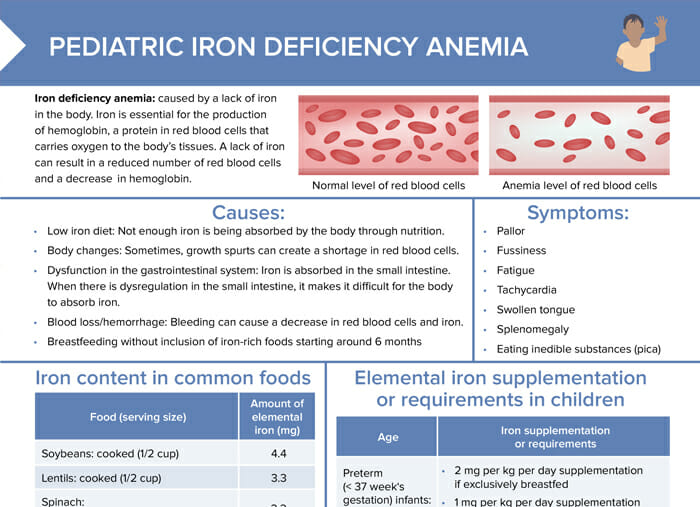What is iron deficiency anemia?
Iron deficiency anemia is caused by a lack of iron in the body. Iron is essential for the production of hemoglobin, a protein in red blood cells that carries oxygen to the body’s tissues. A lack of iron can result in a reduced number of red blood cells and a decrease in hemoglobin.
What causes iron deficiency?
Iron deficiency can be caused by:
- Low iron diet: Not enough iron is being absorbed by the body through nutrition.
- Body changes: Sometimes, growth spurts can create a shortage in red blood cells.
- Dysfunction in the gastrointestinal system: Iron is absorbed in the small intestine. When there is dysregulation in the small intestine, it makes it difficult for the body to absorb iron.
- Blood loss/hemorrhage: Bleeding can cause a decrease in red blood cells and iron.
- Breastfeeding without inclusion of iron-rich foods starting around 6 months
Iron deficiency symptoms
Symptoms of iron deficiency in children include:
- Pallor
- Fussiness
- Fatigue
- Tachycardia
- Swollen tongue
- Splenomegaly
- Eating inedible substances (pica)
How to treat iron deficiency in children
Iron deficiency treatment options
Treating iron deficiency in children typically involves dietary modifications and iron supplementation. Commonly prescribed supplements are oral ferrous sulfate or other iron salts, usually administered on an empty stomach. Dietary modifications with an increased intake of iron-rich foods is another measure. They should be paired with citrus/vitamin-C-rich foods to enhance iron absorption. Calcium-rich foods should be avoided, since they can decrease iron absorption.
Affected children should be checked for potential underlying causes of the iron deficiency, such as frequent blood loss, malabsorption, or chronic disease.
Iron requirements and supplementation recommendations
Preterm infants (1–12 months):
2 mg per kg per day should be supplemented if infant is exclusively breastfed. If infant is fed with iron-fortified formula, supplementing 1 mg per kg per day is sufficient.
Term infants (4–6 months to 12 months):
If infant is exclusively breastfed, iron supplementation recommendation is 1 mg per kg per day. If Infant is fed with iron-fortified formula, no supplementation is needed.
Toddlers (1–3 years):
Toddlers require 7 mg of elemental iron per day. If anemic, modify diet and/or supplement.
Children (4–8 years):
Children of this age require 10 mg of iron per day. If anemic, modify diet and/or supplement.
How to test for iron deficiency
Important lab values to look for are hemoglobin (< 11 g/dL), hematocrit (< 31%–40%, depending on age), MCV (< 73–80 fL, depending on age), and RDW (< 12%).
Iron-rich foods for kids
Table: Iron-rich foods for kids
| Food (serving size) | Amount of elemental iron (mg) |
| Cooked soybeans (½ cup) | 4.4 |
| Cooked lentils (½ cup) | 3.3 |
| Cooked/boiled and drained spinach (½ cup) | 3.2 |
| Cooked beef (3 oz) | 2.5 |
| Cooked lima/navy/kidney/pinto beans (½ cup) | 1.8–2.2 |
| Baby food brown rice cereal (dry) (1 tbsp) | 1.8 |
| Baby food green beans (6 oz) | 1.8 |
| Baby food oatmeal cereal (dry) (1 tbsp) | 1.6 |
| Turkey and chicken: dark meat (3 oz) | 1.1–2.0 |
| Baby food lamb or chicken (2,5 oz) | 1.0–1.2 |
| Baby food peas (3,4 oz) | 0.9 |
Before and after iron deficiency: eyes
Iron deficiency can manifest with visible symptoms affecting the eyes. Note that these are not diagnostic on their own.
In clients with iron deficiency anemia, the conjunctiva can appear paler than usual. The whites of the eyes may have a bluish tint. In severe cases, a lack of iron can lead to small bleeds in the retina.
Upon restored normal iron levels, the conjunctiva should regain its natural pink-red color; the sclera should be white, and retinal hemorrhages heal over time.

